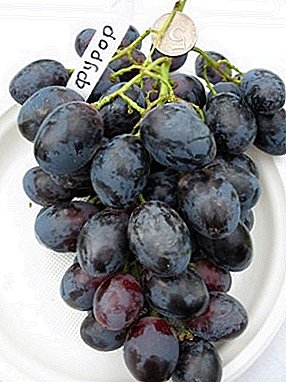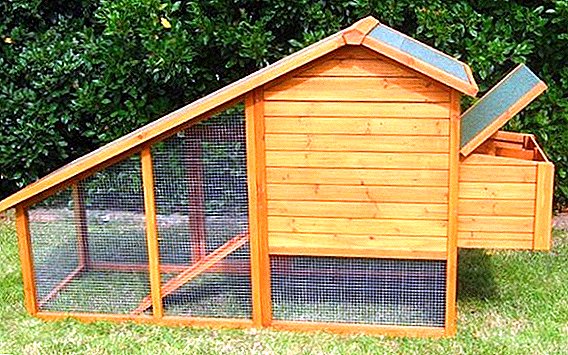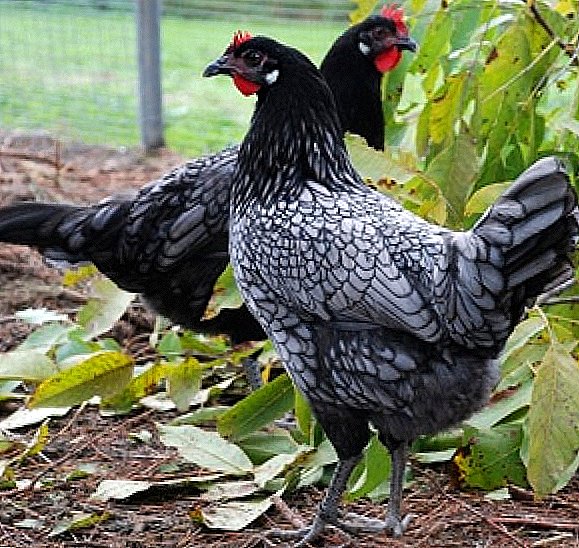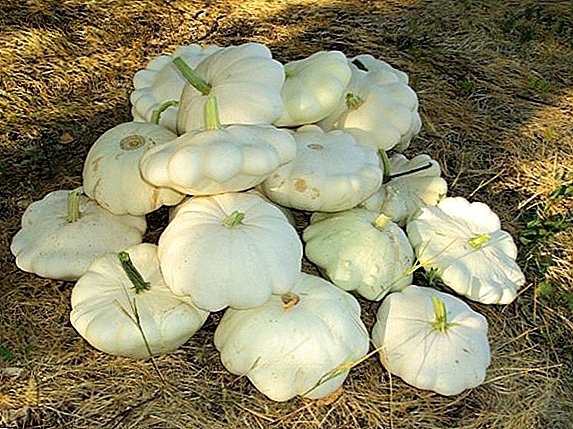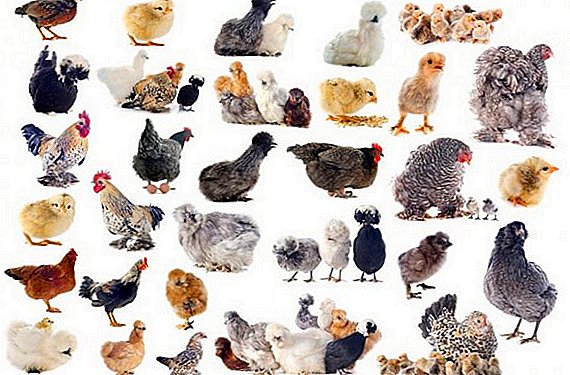 Chicken, of course, is the most common agricultural bird, which is purposefully grown almost all over the world. Today it is even difficult to imagine this animal living in the wild. And it is not surprising, because it is believed that the chicken was the first creature that man managed to domesticate. It is all the more interesting to find out how the relationship between a man and one of his main birdies began and lined up over many centuries - this is further in the article.
Chicken, of course, is the most common agricultural bird, which is purposefully grown almost all over the world. Today it is even difficult to imagine this animal living in the wild. And it is not surprising, because it is believed that the chicken was the first creature that man managed to domesticate. It is all the more interesting to find out how the relationship between a man and one of his main birdies began and lined up over many centuries - this is further in the article.
The origin and history of the domestication of chickens
Modern science is not certain when the domestication of chickens began. Previously, it was customary to say that this happened about four thousand years ago, later data appeared that allowed this moment to be attributed to the end of the fourth millennium BC, and today scientists assume that the chicken is purposefully bred for eight, or even ten thousand years. !
Wild ancestors
It is believed that the ancestors of all currently existing layer breeds are red jungle chickensalso known as wild bankivans chickens (Latin name "Gallus gallus", or "Gallus bankiva"). These birds are close relatives of pheasants and are still found in the wild on the territory of Southeast Asia, particularly in India, Myanmar (Burma), on the Malacca peninsula and on the island of Sumatra, preferring tropical bamboo forests and dense thickets of shrubs.  Gallus gallus These birds are small in size (the mass of males does not exceed 1.2 kg, layers weigh 500 g or a little more), fly well, nest right on the ground and have a very fearful character. In their colors, there are usually black stripes on a red or golden background, which is very similar to the Italian quail breed of chickens, also known as brown leggorn.
Gallus gallus These birds are small in size (the mass of males does not exceed 1.2 kg, layers weigh 500 g or a little more), fly well, nest right on the ground and have a very fearful character. In their colors, there are usually black stripes on a red or golden background, which is very similar to the Italian quail breed of chickens, also known as brown leggorn.  Banking Chickens For the first time, Gallus gallus was named as the ancestor of the current domestic chicken, Erasmus Darwin, whose grandson we all know as the author of an evolutionary theory of the origin of species, and who repeated his grandfather's assumption in his book “Changing Animals and Plants in the Home Condition” (1868).
Banking Chickens For the first time, Gallus gallus was named as the ancestor of the current domestic chicken, Erasmus Darwin, whose grandson we all know as the author of an evolutionary theory of the origin of species, and who repeated his grandfather's assumption in his book “Changing Animals and Plants in the Home Condition” (1868).
Did you know? It is believed that the history of birds began about 90 million years ago, and the first birds had teeth that were replaced by a modern beak thirty million years later!
In addition to red, there are three more types of jungle chickens - gray, Ceylon and green, and until recently it was thought that our ancestors used Gallus gallus for domestication.  Gallus sonneratii However, recent studies call this point of view into question. So, in 2008, scientists from Uppsala University proved that with the obvious similarity of the genotype of domestic chicken to Gallus gallus, one of the genes is closer to gray jungle variety. From here, a sensational assumption has been made that the modern poultry is a descendant of several species of jungle chickens. Most likely, a domesticated variety of Gallus gallus was first obtained, and then it was crossed with Gallus sonneratii (gray jungle chicken).
Gallus sonneratii However, recent studies call this point of view into question. So, in 2008, scientists from Uppsala University proved that with the obvious similarity of the genotype of domestic chicken to Gallus gallus, one of the genes is closer to gray jungle variety. From here, a sensational assumption has been made that the modern poultry is a descendant of several species of jungle chickens. Most likely, a domesticated variety of Gallus gallus was first obtained, and then it was crossed with Gallus sonneratii (gray jungle chicken).
Video: Gallus gallus bankers
Time and domestication centers
Since both the external signs and the behavior of modern poultry are not too different from their wild ancestors, most likely, the man did not have to work hard, domesticating this representative of birds.
The process started, judging by the range of Gallus gallus, somewhere in Asia. There is no single opinion not only on the exact (or at least approximate) date of taming the bird, but even on whether it happened progressively, spreading from one point throughout the world, or carried out in parallel in different places. So, archeologists discovered the remains of domestic chickens on the peninsula Hindustan - they are attributed to the beginning of 2 millennia BC, while the Chinese finds are much more ancient - they are about 8 thousand years old (although these data are already being questioned today). And at the turn of the twentieth and twenty-first centuries, it was generally suggested that the historical homeland of poultry is Thailand.
Important! Most likely, the domestication of the chicken took place nevertheless in several places independently of each other. There are at least nine such centers today, and they are located in different parts of Southeast Asia and the Indian Subcontinent.
However, the history of bird domestication is covered with mystery also because, as it turned out, modern Gallus gallus have already lost their original appearance because of their uncontrolled cross-breeding with domestic chickens.  Engraving by Francis Barlow (1626-1704) But today the fact that domestication took place by selecting the largest wild birds and their subsequent crossing between them is considered reliable. This finding led to the identification in poultry of a much higher level of thyroid-stimulating hormone responsible for growth than in wild animals.
Engraving by Francis Barlow (1626-1704) But today the fact that domestication took place by selecting the largest wild birds and their subsequent crossing between them is considered reliable. This finding led to the identification in poultry of a much higher level of thyroid-stimulating hormone responsible for growth than in wild animals.
Spreading chickens
From Southeast Asia, domestic chicken gradually spread throughout the world. Most likely, the birds first hit the Near Eastin particular in Mesopotamia, Egypt and Syria.
Interestingly, in these countries, a strange bird was treated not as a food but as a sacred animal. Images of roosters were found in the tombs of the Egyptian pharaohs (in particular, Tutankhamen, who died in 1350 BC) and on the Babylonian monuments.
Did you know? It was the ancient Egyptians who belonged to the idea of the first incubator. True, the initially artificial "hatching" of eggs was the prerogative of the priests, the servants of Osiris. But in the era of the dark Middle Ages, this venture, on the contrary, was recognized as the machinations of the devil and banned on pain of death.
 Image of a rooster, Corinth, V st. BC er In the era of antiquity chickens penetrated into the territory Ancient greece. Most likely, in the V - VI centuries BC. er they were already quite widely bred, and, according to the testimony of the ancient Greek comedian Aristophanes, this occupation was affordable even for the poor.
Image of a rooster, Corinth, V st. BC er In the era of antiquity chickens penetrated into the territory Ancient greece. Most likely, in the V - VI centuries BC. er they were already quite widely bred, and, according to the testimony of the ancient Greek comedian Aristophanes, this occupation was affordable even for the poor.
However, the Greeks, known for their love of sport, viewed the chicken primarily as a fighting bird, so it was to the Hellenes that dubious entertainment, like cockfighting, owes its appearance.  Cockfighting. Mosaic of Pompeii, National Archaeological Museum of Naples
Cockfighting. Mosaic of Pompeii, National Archaeological Museum of Naples
According to legend, in 310 BC, during the campaign of Alexander the Great in India, the prince of Punjab paid off a great commander with silver coins, on which a majestic rooster was engraved with huge spurs.
Around the same time, chickens appeared in the states Central Asia - Khorezm, Margiana, Bactria and Sogdiana, where they were also originally worshiped as sacred animals, guardians of Good, personifying the Sun and opposing the destructive forces of Evil. Most likely, this attitude is connected with the characteristic feature of the rooster with a ringing cry to announce the beginning of a new day, which our superstitious ancestors perceived as a symbolic sign of the victory of Light over Darkness. Chicken bones were discovered by archaeologists in the ancient tombs of these countries, which also emphasizes the non-gastronomic attitude to this animal.
From ancient Greece and its colonies poultry penetrated the rest of the territory Western europeas well as in Kievan Rus.  Edgar Hunt "The Rooster and the Three Chickens" The situation with the history of the conquest of chicken is a bit more complicated Africa and America. The black continent, as previously thought, opened up to the bird thanks to Egypt, but there is evidence that this could have happened much earlier. Thus, according to one of the versions, domestic chickens came to Somalia and the Arabian Peninsula from India, that is, they entered the continent not by land, but by sea, and this happened as early as the 2nd millennium BC.
Edgar Hunt "The Rooster and the Three Chickens" The situation with the history of the conquest of chicken is a bit more complicated Africa and America. The black continent, as previously thought, opened up to the bird thanks to Egypt, but there is evidence that this could have happened much earlier. Thus, according to one of the versions, domestic chickens came to Somalia and the Arabian Peninsula from India, that is, they entered the continent not by land, but by sea, and this happened as early as the 2nd millennium BC.
It was also not possible to reliably establish whether the chicken was brought to America by the Spaniards or this bird “discovered” the New World long before Columbus.
Varieties of domestic chickens
For several millennia, during which a person breeds domestic chickens, a huge number of very different breeds of these birds were bred. The decorative and fighting direction of the use of the descendants of Gallus gallus is still preserved, but today the most common area of use for the animal is the food industry.  However, since chicken eggs are not less popular than meat in terms of nutritional value three main areas:
However, since chicken eggs are not less popular than meat in terms of nutritional value three main areas:
- egg;
- meat and egg;
- meat.
Representatives of each of these species of birds differ in certain features.
Familiarize yourself with the ratings of varieties of egg and meat hens.
Egg breeds
The main thing in the egg breed - high egg production rates. In this case, it is important not only the average number of eggs that are laid down by one hen throughout the year, but also the age limits of egg production (age of the first clutch and the period of conservation of peak productivity). To achieve such parameters, one has to sacrifice other qualities that are also valued in poultry.  As a result, egg breeds are distinguished:
As a result, egg breeds are distinguished:
- early onset of egg production - usually 4-5 months;
- the annual number of eggs from one hen is from 160 to 365;
- relatively small size;
- increased demands on the amount of feed and especially on the content of calcium in it (it is necessary for the formation of egg shells and, in addition, is deposited in the egg itself);
- high activity;
- poorly expressed incubation instinct.
External signs of egg breeds, in addition to small sizes, are very dense plumage, as well as a narrow body with well-developed wings.  The most popular egg breeds and crosses, their main characteristics are shown in the table:
The most popular egg breeds and crosses, their main characteristics are shown in the table:
| Breed name | Country of origin | Annual number of eggs | Average egg weight | Average sizes (mass of rooster / chicken, kg) |
| Andalusian | Spain | 190-220 | 55 | 3,2-3,6/2,3-2,7 |
| Russian white | the USSR | 220-250 | 55-60 | 2-2,5/1,6-1,8 |
| Italian partridge | Italy | 180-240 | 60 | 2-3/1,5-2 |
| Hamburg | Germany, UK, Holland | 220 | 55 | 2-2,5/1,5-2 |
| Kampinskaya | Belgium | 135-145 | 55-60 | 1,8-2,6/1,5-2 |
| Leggorn | Italy | 365 | 55-58 | 2,3-2,6/1,5-2 |
| Carpathian greensmill | Poland (probably) | 180 | 50 | 2,2-2,7/1,8-2,3 |
| Minorca | Spain, Holland | 200 | 56-59 | 3,2-4/2,7-3,6 |
| Czech golden | Czechoslovakia | 150-170 | 54-57 | 2-2,5/1,6-2,2 |
| Hisex | Holland | 300 | 60 | 2,4-2,6/1,8-2 |
Hens of araukan, ameraukan, legbar, uheilyuyu, maran, can please with eggs of various colors - from blue and olive to chocolate.
Meat-egg breeds
The main feature of the rocks of this direction is their versatility. Such birds are best suited for small private farms, because they make it possible to always have fresh eggs and very tasty meat on the table. Meat-egg chickens gain weight more slowly than meat, but still in size usually exceed their counterparts in the egg direction, lagging behind the latter in terms of egg production. Another feature of almost all breeds is that they are more often than "egg", show aggressiveness and worse tolerate content in closed cages.  The most successful breeds and crosses of meat and egg direction:
The most successful breeds and crosses of meat and egg direction:
| Breed name | Country of origin | Annual number of eggs | Average egg weight | Average sizes (mass of rooster / chicken, kg) |
| Kuchinsky anniversary | the USSR | 200 | 60 | 3-3,8/2,3-2,6 |
| Moscow black | the USSR | 180 | 61 | 2,9-3/2,3-2,6 |
| Adler silver | the USSR | 170 | 62 | 3,6-3,8/1,2-1,4 |
| Yerevan | Armenia | 160 | 57 | 2,9-3,2/1,9-2,1 |
| Rhode Island | USA | 170 | 60 | 3,2-4/2,5-2,8 |
| New Hampshire | USA | 200 | 65 | 3,9-4/2,5-2,9 |
| Sussex | Great Britain | 150-200 | 60 | 2,9-3/2,3-2,5 |
| Amrox | Germany | 220 | 60 | 4-4,5/3,3-3,5 |
| Hercules | Russia | 200-240 | 60-70 | 6-6,5/3,3-3,7 |
| Pushkinskaya | Russia | 220-270 | 58-60 | 2,5-3/1,8-2 |
| Plymouth Rock | USA | 170 | 55-50 | 4,8-5/3,3-3,6 |
Did you know? Champions in eating chicken are the Jews. According to statistics, every resident of Israel eats about 67.9 kg of this meat per year. In the US, this figure is slightly lower, only 51.8 kg, while in Russia per capita only 22.1 kg of chicken meat per year is accounted for.
Meat breeds
Meat breeds of chickens are large. They are heavy and stocky, have massive strong paws and soft plumage. Usually such birds are phlegmatic and stress-resistant, they are not afraid of people, they are not demanding to conditions of detention. Meat breeds are not rushing as actively as egg breeds, but the instinct of brooding of chicks in the hens is well developed.  Among the best meat breeds and crosses of chickens are the following:
Among the best meat breeds and crosses of chickens are the following:
| Breed name | Country of origin | Annual number of eggs | Average egg weight | Average sizes (mass of rooster / chicken, kg) |
| Brama | USA | 125 | 60 | 4-4,5/3-3,5 |
| Jersey giant | USA | 180 | 55-56 | 5-5,9/3,6-4,5 |
| Dorking | Great Britain | 140 | 65 | 4-4,5/3-3,5 |
| Cochinquin | China | 100-135 | 50-60 | 5-5,5/4-4,5 |
| Cornish | Great Britain | 130-160 | 56-60 | 3,5-4/3-3,3 |
| Malin | Belgium | 140-160 | 53-65 | 4-5/3-4 |
| Orpington | Great Britain | 160-180 | 60-61 | 4-5/3-4 |
| Fireball | France | 160-180 | 55-58 | 4-4,5/3-3,5 |
| Langshan | China | 100-110 | 55-56 | 3,5-4/3-3,5 |
| Master gray | Hungary | 200 | 60-70 | 6-7/2,5-2,9 |
| Foxy chick | Hungary | 250-300 | 70 | 4-4,5/3,5-4 |
There are also other groups of breeds of chickens - decorative (for example, Chinese silk, sybright, gudan, paduan, shabo, milfleur), fighting (chamo, sumatra, azil) and vociferous (jurlovskie).
Content and behavior
The conditions of the home chicken are largely dependent on the breed. In general, we are talking about a rather unpretentious bird. For her, almost any dry and clean room is suitable. Active egg hens need more free space than their more phlegmatic beef congeners. In the first case, it is necessary to proceed from the fact that on one square meter of space there were no more than 2-3 feathered inhabitantsin the second they can make room for up to 3-5 individuals. Meat-egg breeds are not quarrelsome, so in this category it is better to be guided by the same requirements as for egg ones.  In the middle of the house, perches should be equipped (they are set at a height of 1 m above the floor level at the rate of 20 cm of space on each bird), and also provide nests for egg laying. The floor is best covered with boards, then in winter there will be no need for additional insulation. In addition to the feeders and drinkers, in the chicken coop should be installed "baths" for dry bathing, in which you need to pour (and periodically refresh) a mixture of ash, sand and clay. This procedure is an excellent prevention of various skin and feather parasites.
In the middle of the house, perches should be equipped (they are set at a height of 1 m above the floor level at the rate of 20 cm of space on each bird), and also provide nests for egg laying. The floor is best covered with boards, then in winter there will be no need for additional insulation. In addition to the feeders and drinkers, in the chicken coop should be installed "baths" for dry bathing, in which you need to pour (and periodically refresh) a mixture of ash, sand and clay. This procedure is an excellent prevention of various skin and feather parasites.
Important! Chickens in general tolerate cold well, but for them it is very important that there is no drafts and humidity in the room.
An important condition for healthy livestock is also regular cleaning of the chicken coop and changing beddingif it is used.
For most chickens, especially egg and meat-egg strands, walking in the open air is very useful. So the birds have the opportunity to diversify their diet at the expense of various insects and worms, which not only greatly strengthen their immunity, but also allow the farmer to save some of the money on feed. 
Nutrition and feeding
Proteins, fats, carbohydrates, minerals and vitamins (especially A, B and D) must be present in the diet of the feathered herd. There are special combined feed for poultry, in which these elements are presented in a balanced form, but such food will cost the farmer quite expensive.
It is more economical to use products and household waste for feeding birds, in particular, for this purpose fit:
- potatoes, carrots, beets, pumpkins, cabbage (leaves), apples, pears, plums, other vegetables and fruits, including their cleaning and the crook, as well as non-marketable specimens (small or germinated, but not rotten or moldy );
- black and white bread, including crusts and crumbs (all this should be soaked beforehand);
- offal and waste remaining after cutting fish and meat, including shredded bones;
- milk, whey, cottage cheese, sour milk (mollusks, frogs, bugs, worms and other animals are also a source of protein, but if chickens have the opportunity to walk, they will take care of this part of the diet);
- vegetable cake and meal.
 However, the basis (about 60%) of the chicken ration should be grain, in particular, corn, wheat, oats, rye, barley, and also legumes.
However, the basis (about 60%) of the chicken ration should be grain, in particular, corn, wheat, oats, rye, barley, and also legumes.
Did you know? The production of chicken in the world is growing steadily, far ahead of the pace of production of beef and pork. Thus, in the 70s of the last century, about 20 million tons of poultry were produced in the world, in 20 years this number had risen to 40 million, and by 2020, according to some forecasts, it will be 120 million tons. The absolute numbers are even more impressive: in 1961, 6.5 billion chickens were killed, in 2011 - 58.4 billion, and in 2014 - already 62 billion individuals!
You can feed an adult bird two or three times a day, and in the first half of the day it is better to give soft and juicy food (vegetables, mash, greens, etc.), and in the evening dry and hard (grain). With this method of feeding uneaten and perishable residues can be removed in a timely manner, without leaving them at night in the feeders. 
Breeding
In order to ensure maximum egg production and optimal conditions for incubation of eggs, it is necessary to adhere to following rules:
- Equip the chicken coop with warm nests (wooden boxes about 35 cm deep can be used) lined with straw, hay or sawdust and placed in the most secluded place.
- Systematically change litter in nests and disinfect the floor and walls of the chicken coop (it is better to do this while the livestock is on the range).
- Provide the birds with proper lighting: the windows in the hen house should be at least 1/10 of the floor area. In addition, during the cold season, it is necessary to artificially increase the length of daylight hours to at least 12-14 hours with the help of special lighting.
- The maximum air temperature in the chicken coop should not exceed + 25 ° C, the minimum should not fall below + 15 ° C.

Rearing
Выражение "цыплят по осени считают" не зря стало крылатым. The fact is that newly hatched chickens are very demanding in their care and can die during the first month from hypothermia, overheating, drafts, unhealthy diet, as well as due to violation of the requirements for cleanliness and dryness of the room.
Important! Room temperature for chicks is too low. During the first 5 days of life they will need 29-30 ° C, then the temperature can be gradually reduced by 2-3 ° weekly. When chicks are a month old, they will be able to feel comfortably at + 18 ° С.
It is best to heat the room where chicks are kept with infrared lamps.
For kids it is important to create a sufficient amount of free space. So, if newly hatched chicks can crowd 20-25 individuals per square meter, then by the time they reach a month of age, this number should be reduced to 15, and by two or three months - to 10 animals per square meter.  The first feed for the chicks should not be given immediately after they leave the egg, but after 12-16 hours (you can leave the bird hungry for a day: there is enough food left from the egg so that the chick does not experience hunger), and for this purpose The best thing is not boiled egg yolk, as they usually say, but corn flour (protein food, according to the latest data, is still too fat for small chicks).
The first feed for the chicks should not be given immediately after they leave the egg, but after 12-16 hours (you can leave the bird hungry for a day: there is enough food left from the egg so that the chick does not experience hunger), and for this purpose The best thing is not boiled egg yolk, as they usually say, but corn flour (protein food, according to the latest data, is still too fat for small chicks).
At first, chicks can be kept in a special box - broder.
The first days of chickens are fed every two hours, gradually reducing the number of meals, first to seven, and then to three or four times a day. Starting from the third day, cottage cheese, finely chopped greens, ground oatmeal, as well as special feed for chickens are gradually introduced into the diet. From the second week, mash potatoes, crushed boiled vegetables are added, and as the chicks grow, their ration is systematically brought out to the normal diet of adult poultry.  The domestication of the chicken could perhaps be compared in importance with the invention of the wheel. Since this process began several thousand years ago, people have developed a huge number of very different species and breeds of this bird. It is grown today not only for meat and eggs, as well as feather and fluff, but also for entertainment (fighting breeds) and even for beauty (decorative breeds). In terms of useful qualities and productivity, no animal, of all, who has ever been tamed by man, can compete with chicken.
The domestication of the chicken could perhaps be compared in importance with the invention of the wheel. Since this process began several thousand years ago, people have developed a huge number of very different species and breeds of this bird. It is grown today not only for meat and eggs, as well as feather and fluff, but also for entertainment (fighting breeds) and even for beauty (decorative breeds). In terms of useful qualities and productivity, no animal, of all, who has ever been tamed by man, can compete with chicken.




